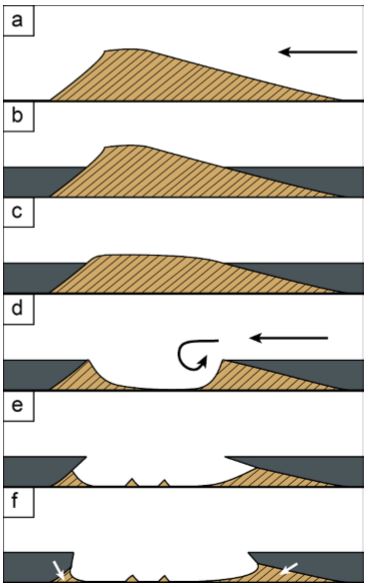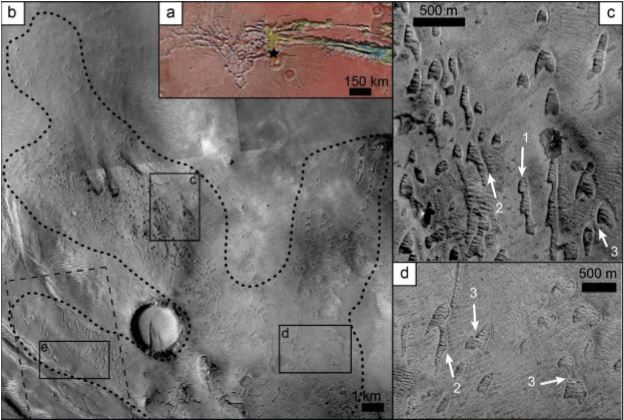Martian 'Ghost Dunes' Could Preserve Signs of Ancient Life

Could pits hold evidence of ancient Mars life? Researchers just found hundreds of crescent-shaped depressions on the surface of the Red Planet. These pits likely used to be sand dunes — each one the size of the U.S. Capitol building, according to researchers.
These 'ghost dunes' remain preserved because of their composition. Lava or sediments washed into the area with water and partially buried these dunes as it streamed around them. Like a mold, the buried part of the dune hardened over time. After wind blew the exposed sand away, the mold inside remained and showed where the full dune used to be.
And maybe life is hiding there. In a statement from the American Geophysical Union, the research team said the tip of the trailing ends of each of these dunes might have enough shelter to preserve a bit of sand. Inside this sand could be signs of ancient life, protected from the radiation-heavy Mars environment. [Boiling Blood and Radiation: 5 Ways Mars Can Kill]
"We know that dunes on Earth can support life, and dunes on Earth are very similar to dunes on Mars," lead author Mackenzie Day, a planetary geomorphologist (someone who studies planetary surface changes) at the University of Washington in Seattle, said in the statement.
"One problem that Mars has that Earth doesn't is the surface radiation. If you are inside a dune, or at the bottom of a dune, and you are microbial life, the dune is protecting you from a lot of that radiation," Day added. "There is probably nothing living there now. But if there ever was anything on Mars, this is a better place than average to look."
Similar to active dune fields
Features like this aren't unique to Mars. The first ghost dunes were found on Earth in 2016 in the Snake River Plain, in eastern Idaho. On Mars, the new study uncovered similar-looking features in Mars Reconnaissance Orbiter images of the southern hemisphere at Hellas (an ancient impact crater) and Noctis Labyrinthus (a set of deep valleys.)
The ghost dunes probably stood about 40 meters (130 feet) tall at Noctis Labyrinthus and 75 meters (246 feet) tall at Hellas basin just before they were buried. They also appear to be barchan dunes – common dune types on both Mars and Earth. Barchan dunes are crescent-shaped features that occur on flat surfaces with little sand, in zones where the wind blows mostly from one direction.
Breaking space news, the latest updates on rocket launches, skywatching events and more!
The observations also suggest these pits have a similar size and shape to active dune fields on Mars, especially because the pits are aligned in the same way as today's dunes.
"Any one of these pits is not enough to tell you that it's a dune, or from an ancient dune field. But when you put them all together, they have so many commonalities with dunes on Mars and on Earth that you have to employ some kind of fantastic explanation to explain them as anything other than dunes," Day said.
"They are all going the same way," she added, "which you would expect for dunes, because they are all migrating and forming in the same wind regime. So just the shape and size tell us that these are features that are coming from an ancient dune system." [Gullies Streak Down Mars Crater in Stunning NASA Photo]
Reconstructing the ancient environment
The ghost dunes probably were buried about 2 billion years ago, during the late Hesperian or early Amazonian period on Mars. The Hesperian is a transitional period in Martian history, when the planet changed from a wetter environment into the drier and wind-swept planet observed today. Researchers are still trying to understand why the climate changed; according to a leading hypothesis, the atmosphere thinned, making it impossible for water to flow on the surface.
The two sets of dunes might have been buried differently, the researchers said. Noctis Labyrinthus lies near previously active volcanoes, while the Hellas basin dune field is downstream of two large canyons that likely were shaped by water.
"If some of the water that carved those valleys made it downstream far enough, it could have gotten to the dune field," Day said. "The only thing that we know for sure is that the flow had to be relatively low energy, relatively slow, otherwise it would erode the dunes and we wouldn't get the shapes that we see today."
Besides giving clues of ancient life, the dunes could also show how the winds used to blow during earlier parts of Mars' history. This knowledge would help researchers better understand how sediments moved over the surface, the formation of large features and how the climate of the ancient past is different from atmospheric conditions observed today.
"The fact that the wind was different [when the ghost dunes formed] tells us that the environmental conditions on Mars aren't static over long timescales, they have changed over the past couple billion years, something we need to know to interpret the geology on Mars," Day said.
The new work was detailed June 5 in the Journal of Geophysical Research: Planets.
Follow us @Spacedotcom, Facebook and Google+. Original article on Space.com.

Elizabeth Howell (she/her), Ph.D., was a staff writer in the spaceflight channel between 2022 and 2024 specializing in Canadian space news. She was contributing writer for Space.com for 10 years from 2012 to 2024. Elizabeth's reporting includes multiple exclusives with the White House, leading world coverage about a lost-and-found space tomato on the International Space Station, witnessing five human spaceflight launches on two continents, flying parabolic, working inside a spacesuit, and participating in a simulated Mars mission. Her latest book, "Why Am I Taller?" (ECW Press, 2022) is co-written with astronaut Dave Williams.




